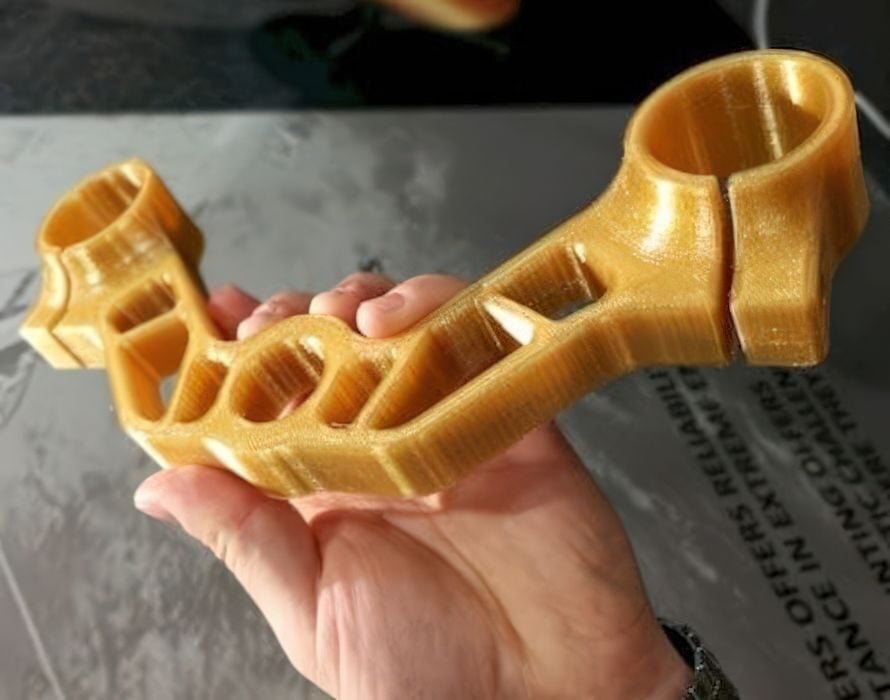
Additive manufacturing of high-performance, high-temperature plastics is essential for aerospace applications.
Additive manufacturing (AM) offers numerous benefits for aerospace applications, such as new possibilities for lightweighting, part consolidation and highly complex geometries. However, in the context of aerospace manufacturing, 3D printing technology has often been challenged by a lack of validated and certified materials. Fortunately, as the AM industry has matured, the availability of material options has concordantly increased, unlocking many new opportunities for 3D printing aerospace components.
In this context, polyether ether ketone (PEEK), polyetherketoneketone (PEKK) and polyetherimide (also known as PEI or ULTEM) are particularly notable for their excellent mechanical and chemical resistance properties, which are retained under high temperatures. In fact, the relatively high heat resistance of these thermoplastics is both a benefit for aerospace applications and a challenge for 3D printing, especially when comparing them to other standard plastics, such as polylactic acid (PLA) and acrylonitrile butadiene styrene (ABS).
3D Printed PEEK Parts for Aerospace
PEEK has several key properties that make it appealing for aerospace applications. These include its high strength-to-weight ratio, thermal resistance, chemical and corrosion resistance and low outgassing. The latter is particularly critical for spacecraft and satellite applications. In addition, PEEK meets the flame, smoke and toxicity (FST) requirements for the FAA and EASA.
With the advancement of 3D printing technologies, there are now several options for 3D printing PEEK aerospace components. Some fused filament fabrication (FFF) machines can process PEEK, though these need high temperature extruders capable of operating at 400˚C, as well as heated platforms and build chambers. Selective laser sintering (SLS) can produce parts from PEEK powder, and has the advantages over FFF of not requiring supports and operating at higher resolutions, though these also come at a higher cost.
Additive Manufacturing with PEKK for Aerospace
Like PEEK, PEKK offers a high strength-to-weight ratio, with some suppliers claiming that PEKK parts can be as strong as aluminum at less than half the weight. PEKK also has excellent wear and chemical resistance, in addition to being easier to 3D print than PEEK due to the former’s lower crystallization rate. This makes it less prone to cooling issues, such as warping. PEKK also meets the FAA and EASA FST requirements for use in commercial and military aircraft.
Although 3D printing PEKK parts with FFF requires a lower extruder temperature (340 – 360˚C), it still requires a heated platform and build chamber. PEKK can also be 3D printed using SLS, with some suppliers offering PEKK powders with carbon fiber compounded in to improve performance.
3D Printing ULTEM for Aerospace
Introduced to the market by General Electric in 1982, Ultem has similar characteristics to PEEK but with a lower impact strength and narrower temperature range. However, it’s also less expensive, with some copolymers, such as ULTEM 9085 CG (certified grade), meeting the FST requirements of the FAA and EASA. Other ULTEM copolymers incorporate recycled scrap or residue and are certified as renewable.
ULTEM 9085 is specifically designed for 3D printing processes, specifically FFF, though the material is sensitive to moisture, which can affect both extrusioTn and the properties of the printed part. Advice on the optimal nozzle temperature for extruding ULTEM varies but there is experimental evidence that resins and composites need a temperature range of 375 – 420˚C for best results.
Read the rest of this story at ENGINEERING.com
